The Fractional Investigation of Fornberg-Whitham Equation Using an Efficient Technique
Hassan Khan,Poom Kumam,Asif Nawaz,Qasim Khan and Shahbaz Khan
1Department of Mathematics,Abdul Wali Khan University,Mardan,23200,Pakistan
2Department of Mathematics,Near East University TRNC,Mersin,10,Turkey
3Center of Excellence in Theoretical and Computational Science(TaCS-CoE)&KMUTTFixed Point Research Laboratory,Room SCL 802 Fixed Point Laboratory,Science Laboratory Building,Departments of Mathematics,Faculty of Science,King Mongkut’s University of Technology Thonburi(KMUTT),Bangkok,10140,Thailand
4Department of Medical Research,China Medical University Hospital,China Medical University,Taichung,40402,Taiwan
ABSTRACT In the last few decades,it has become increasingly clear that fractional calculus always plays a very significant role in various branches of applied sciences.For this reason, fractional partial differential equations (FPDEs) are of more importance to model the different physical processes in nature more accurately.Therefore,the analytical or numerical solutions to these problems are taken into serious consideration and several techniques or algorithms have been developed for their solution.In the current work, the idea of fractional calculus has been used, and fractional Fornberg Whitham equation(FFWE)is represented in its fractional view analysis.A well-known method which is residual power series method(RPSM),is then implemented to solve FFWE.The RPSM results are discussed through graphs and tables which conform to the higher accuracy of the proposed technique.The solutions at different fractional orders are obtained and shown to be convergent toward an integer-order solution.Because the RPSM procedure is simple and straightforward,it can be extended to solve other FPDEs and their systems.
KEYWORDS Caputo derivative;fractional partial differential equations;fornberg-whitham;residual power series method
1 Introduction
In mathematical physics,the Fornberg-Whitham equation is a fundamental mathematical model.The Fornberg-Whitham equation[1,2]is written as:

This equation was introduced to investigate how non-linear dispersive water waves break.The Fornberg-Whitham equation is shown to allow peakon solutions, as well as the occurrence of wave breaking,as a mathematical model for waves of limiting height.Fractional calculus(FC)is now widely used and accepted, owing to its well-established applications in a wide range of seemingly disparate domains of science and engineering[3–7].Many scholars,including Gupta et al.[8],Merdan et al.[9],Singh et al.[10],have examined the fractional extension of the Fornberg-Whitham equation relevant to the Caputo fractional derivative.
FC has the potential to explain various difficult phenomena like memory and heredity.In recent years,researchers have taken a keen interest in the subject of fractional differential equations(FDEs), such as viscoelasticity, fluid mechanics, nanotechnology, electrochemistry, modelling for shape memory polymers,biological population models,optics and signal processing,modelling control theory,the damping behaviour of materials,economics and chemistry,signal processing,creeping and relaxation for viscoelastic materials and diffusion and reaction processes[11–13].Accurate modelling of time-fractional two-mode coupled burgers equation is done with the help of fractional derivatives(FD)[14].
Analytical and numerical techniques are frequently used for the solution of FPDEs and their systems.The fractional problems that have been modelled by using FPDEs are found in various disciplines,because the mathematical modelling of real-life phenomena is usually modelled accurately by using FPDEs.
In this connection, the important fractional mathematical models are solved by using various techniques such as Chun-hui He’s algorithm [15], reproducing kernel method [16], Runge-Kutta method for time discretization and Fourier transform for spatial discretization[17],Fourier spectral method[18],He-Laplace method[19],Fractional variational iteration method[20],operational matrix of fractional Riemann-Liouville integration with Legendre basis and zeros of Chebyshev polynomials[21].Khan et al.[22] have solved nonlinear fractional differential equations using an efficient approach.The non-linear differential equations are solved by using perturbation transform method and He’s polynomials[23].The one-dimensional non-homogeneous partial differential equations with a variable coefficient are solved by using homotopy perturbation method and Laplace transformation[24].Linear and non-linear differential equations arising in circuit analysis are investigated by using Maclaurin series method [25].The analysis of Caputo fractional-order dynamics of Middle East Lungs Coronavirus(MERS-CoV)model are discussed in[26].He’s fractional derivative and fractional complex transform are implemented for the time fractional Camassa-Holm equation [27].The fractional complex transform is utilised to solve time-fractional Schr¨odinger equation [28].A twoscale fractal theory is suggested for the population dynamics[29].The idea of the two-scale fractal is utilised to model the time-fractional tsunami wave traveling on an unsmooth surface[30].A study of projectile motion in a quadratic resistant medium via fractional differential transform method [31].The design of a variable fractional delay(VFD)FIR filter is handled using least square method[32].Homotopy analysis Sumudu transform method is applied to solve delay Fractional Bagley-Torvik equation(HASTM)[33].Coupled fractional Navier-Stokes equation is computed numerically using the proposed q-homotopy analysis transform method (q-HATM) [34].The solutions of the fifthorder dispersive equations with porous medium type non-linearity is investigated by the classical Riccati equations method [35].The analytical solution of time-fractional Navier-Stokes equation is calculated by using Adomian decomposition method [36] and similarly the Residual power series method(RPSM)was used to analyze the solution of fractional partial differential equations[37].
Many researchers have worked hard to find the solutions to FPDEs by using RPSM and other novel techniques that have been used for the solutions of FPDEs like:Senol et al.[38]solved the timefractional nonlinear coupled Jaulent-Miodek system with energy-dependent Schrodinger Potential using RPSM in 2019, Korpinar et al.[39] have analysed the solution of the fractional cancer model by RPSM, Kurt [40] has implemented RPSM to obtain the solution of fractional Bogoyavlensky-Konopelchenko equation,Xu et al.[41]have implemented RPSM to obtain the solution of fractional Boussinesq equations, Freihet et al.[42] have found the solution of fractional Burgers-Huxley equations in by using RPSM.Jena et al.[43] have found the solution of the fractional model of the vibration equation of large membranes using RPSM.
In the current work,the solution of FFWE is investigated by RPSM.The RPSM was found to be a very effective technique for finding the analytical solution of FFWE[44].In the current work,we have applied the RPSM technique to solve different FPDEs and obtained the series form solutions.The closed form series solution is achieved for FFWE by using the proposed analytical technique.The accuracy of RPSM is represented by using graphs and tables.The solutions at different fractional orders are of greater interest, which show the useful information about the actual dynamics of the given problems.The graphs show the convergence of fractional solutions of the targeted problem towards integer order solution.The proposed method is also applied to other physical problems in applied sciences and engineering.The article layout is organized as follows; the fundamental concepts regarding FC are described in Section 2;the basic methodology is discussed in Section 3;the application of RPSM in the Fornberg-Whitham equation involving the Caputo fractional derivative is contained in Section 4;results and discussion are in Section 5 and the conclusion is given in Section 6.
2 Basic Definitions
In this section,we discussed some preliminaries and definitions.
2.1 Definition
The integral operator of Reimann-Liouville having orderϑis given as[45,46]:

Its fractional derivative forϑ≥0 is defined as:

where m is an integer.
2.2 Definition
The Caputo FD operator of the fractional orderσis given as[46]:

The operatorsDσandIσsatisfy the following properties:


2.3 Definition
A Power Series(PS)expansion is defined as[47]:

Theorem
Assume thatu(ℑ,ξ)has a multiple fractional PS representation atξ=ξoof the form[48],

Ifare continuous onI×(ξo,ξo+ℜ),n=0,1,···,then the coefficients offn(ℑ)are given as:
3 RPSM Methodology
To the understand the procedure of RPSM[49–54],let consider FPDEs of the form

having initial condition,
u(ℑ,0)=f(ℑ),
whereis Caputo type fractional derivative of the functionu(ℑ,ξ),L(u)is linear term andN(u)is the non-linear term.Initially,RPSM is used by taking the fractional PS expansion about a fix pointξ=ξo,that is,

the 0thRPSM approximate solutions ofu(ℑ,ξ)is given below as:
uo(ℑ,0)=f(ℑ).
Letuk(ℑ,ξ)represent thekthterm,

exchange thekthtruncated seriesuk(ℑ,ξ)and of Eq.(3)in Eq.(2)which is thekthresidual function and is given as:

Also obtainResu(ℑ,ξ)=It is observed thatResu(ℑ,ξ)=0, ∀values of ℑ ∈[a,b].This Resu(ℑ,ξ)is infinitely differentiable at ℑ =aandResuk(ℑ,0)which provide the basic rule of RPSM technique,allowing it to solve a broad range FPDEs.To determine thekthRPSM solution,we review Eq.(3)and then differentiate with respect to independent variablesℑ andξand finally replaceξ= 0,we obtainfand constant parameters.By replacing these constant parameters inuk(ℑ,ξ),we obtain the kth truncated series,which we then assign to Eq.(4)to obtain an approximate solution.This method can be repeated using RPSM solutions for other arbitrary coefficient orders of Eq.(4).
4 Solution of Time-Fractional F-W Equation
Let us consider the time fractional F-W equation,

with initial condition,

Letuk(ℑ,ξ)denote thekthtruncated series ofu(ℑ,ξ),we have

We define thekthresidual function of FW equation as:


For the first step,k=1 put in FW equation Eq.(8),in the form as:

Now we can write Eq.(7),fork=1,as:

Differentiating of Eq.(10),and put Eq.(9),we have

from Eq.(11),andξ=0,we have

therefore

then from Eq.(7),and Eq.(12),we get

using Eq.(6),put in Eq.(13),then we have

Step 2.fork=2,put in Eq.(8),can be written as:

Now we can written Eq.(7),fork=2,as:

Similarly,
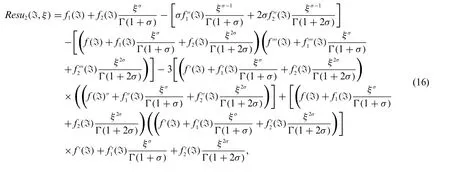
applyingon both sides of Eq.(16)and then putξ=0,yields

Now using Eq.(12)and Eq.(17),in Eq.(15),we get

Putting Eq.(6),and Eq.(12),in Eq.(18),we have

For the third step,puttingk=3,in FW Eq.(8),as:

From Eq.(7),putk=3,the truncated series as:

same as the above procedure
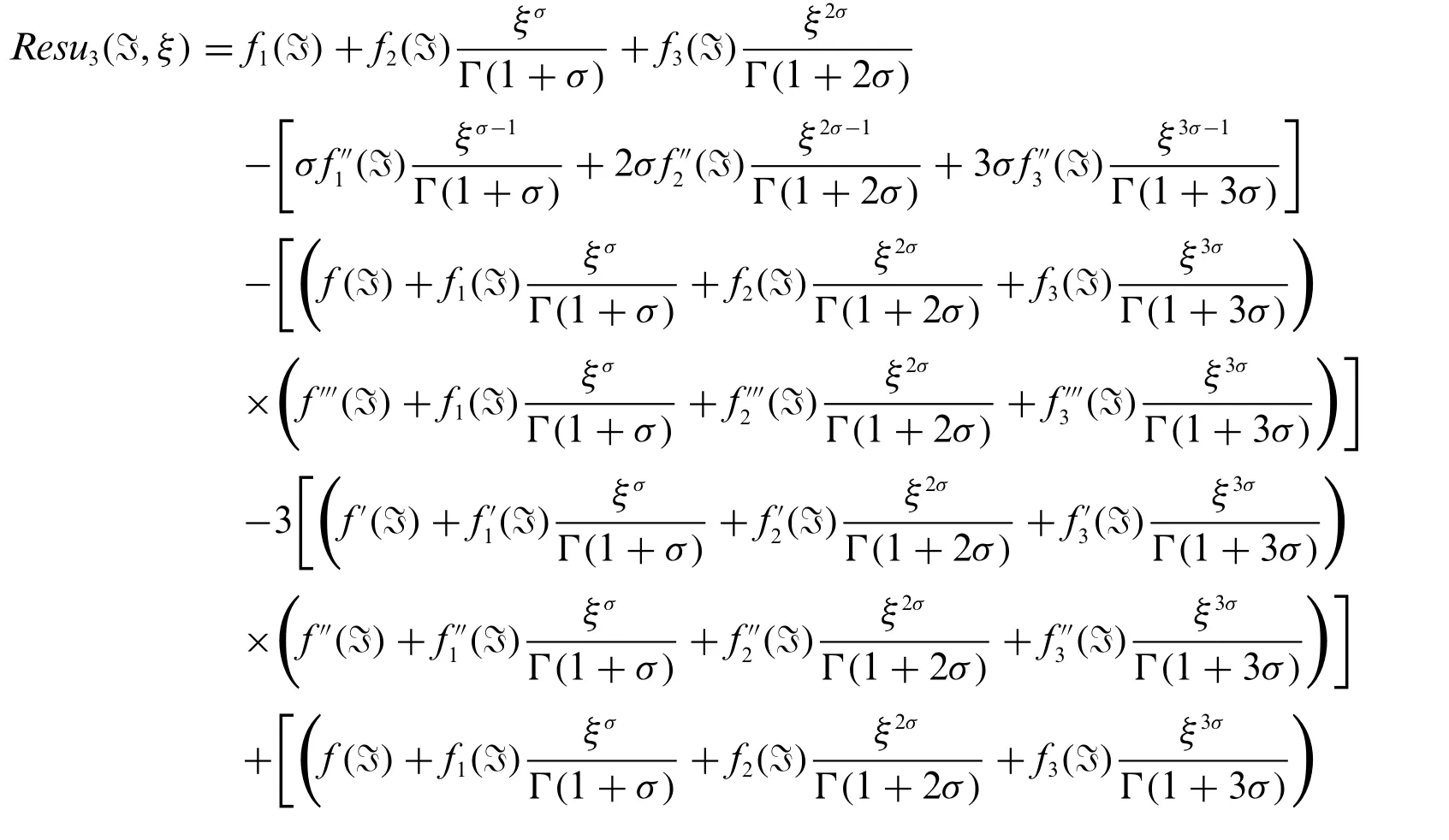

Applyingon both sides of Eq.(21)and then putξ=0,yields

therefore
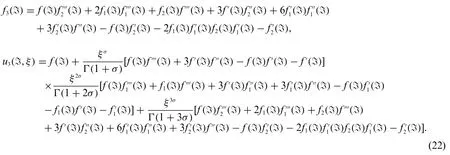
Using Eq.(6),Eq.(12),and Eq.(18),put in Eq.(22),we have

Equivalence of the 3rd-order approximate solution ofu3(ℑ,ξ)with the exact solution is required to demonstrate the capability of the RPSM.Even when a low-order approximate solution,u3(ℑ,ξ),is used,the numerical results show that RPSM performs admirably for the FW equation.The accuracy can be improved by using a higher-order RPSM solution.Eq.(23) provides the 3rd approximate solution of the FW equation.The results are discussed through graphs and tables in the next section of the paper.
5 Results and Discussion
In Fig.1,the exact and RPSM solutions atσ=1 are presented,respectively.The RPSM solution is calculated fork=3,that is up to the third iteration.From Fig.1,it is very clear that the exact and RPSM solutions are very close to each other.The comparison also confirmed the greater accuracy of the present method.The domain of the given problem is -4 ≤ℑ ≤4, while 0 ≤ξ≤4.Fig.2 shows the RPSM solution up to the 3rd iteration atσ= 0.9 andσ= 0.8.The solution graph at the fractional orderσ= 0.9 is slightly different as compared to the integer order solution, which shows another useful dynamics of the given physical problem.Similarly,another solution plot of the targeted problem is discussed atσ= 0.8 is slightly different as compared to the fractional orderσ=0.9.The plots atσ=0.9 andσ=0.8 are vary closed to each other.In Fig.3,the solution graphs of various mathematical models with different fractional orders of the FW equation are displayed.A very consistent relationship is observed between the solutions graphs at various fractional ordersσ.The overall graphical analysis of the problem has provided the opportunity to select that mathematical model of the fractional order which has a close relationship with the actual data of the problem.It is concluded that we have upgraded the existing model with the fractional order derivative to represent the dynamics of any physical problem in a rather sophisticated manner as compared to an integer model.In Fig.3,the 2D solution plot is presented which shows the exact solution of the FW equation.Fig.4 shows the approximate solution of the given problem atσ=1,which is nearly equal to the exact solution.The solutions graphs obtained by exact and approximate solutions are compared with each other.The 2D plots in Figs.3 and 4 are very close to each other in the same fractional order.Another plot in Fig.4 shows us the combined graphs of RPSM solutions at different fractional ordersσ.
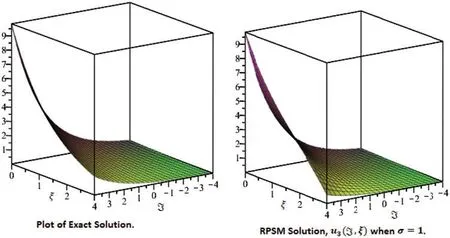
Figure 1:Comparison plots of exact and approximate solutions at the fractional order σ =1
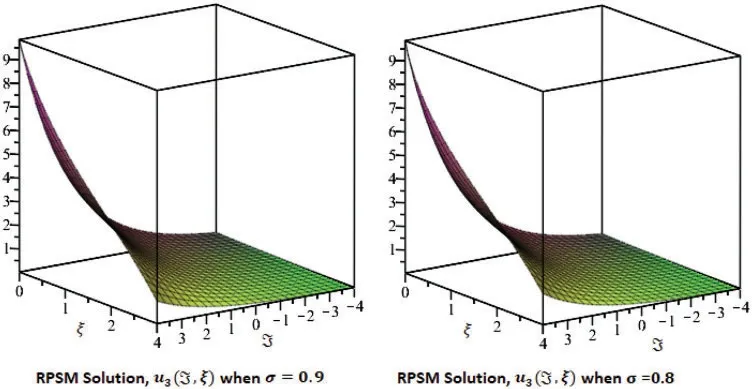
Figure 2:Comparison plots of approximate solutions at the fractional order σ =0.9 and σ =0.8
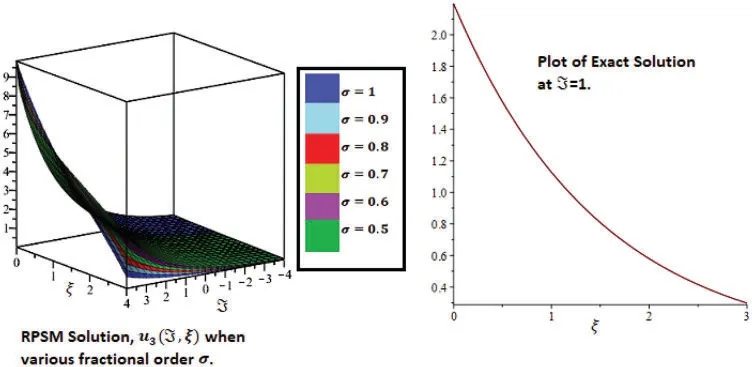
Figure 3:Combine 3D graphs for different fractional orders σ and exact solution of 2D plot
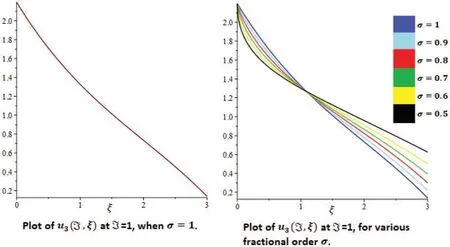
Figure 4:2D plot and combine plot for various fractional order σ
Table 1 lists the result of RPSMu3(ℑ,ξ)solution at various fractional ordersσ.The numerical results have shown that RPSM works excellently to solve FPDEs, even when using low-order approximate solution.The accuracy can be improve by using higher-order approximate solutions of FFWE.The Numerical results for various particular cases ofσare presented in Figs.1–3.

Table 1: Comparison table of exact and RPSM solutions of u3(ℑ,ξ)

Table 1 (continued)ℑ ξ Exact σ =1 σ =0.9 σ =0.8 σ =0.7 σ =0.6 σ =0.5-1 0.01 0.8033340940 0.8046741005 0.8020743991 0.7978910586 0.7912464160 0.7808694041 0.7650268336 0 0.01 1.3244740080 1.3266833050 1.3223971220 1.3154999600 1.3045447970 1.2874359960 1.2613160130 1 0.01 2.1836884690 2.1873309860 2.1802642650 2.1688927670 2.1508307550 2.1226231120 2.0795585410 2 0.01 3.6002936290 3.6062991210 3.5946480680 3.5758996370 3.5461204150 3.4996138740 3.4286123980 3 0.01 5.9358806850 5.9457820710 5.9265727310 5.8956617930 5.8465641560 5.7698878340 5.6528261920 4 0.01 9.7866127450 9.8029373700 9.7712665230 9.7203030030 9.6393546840 9.5129368000 9.3199347810
In Table 2,the solutions comparison of RPSM with He’s HPM is discussed.It is analyzed that the RPSM solution up to three terms is quite closed to the He’s HPM solutions which is calculated up to five terms.The tables and graphs have confirmed the higher degree of accuracy of RPSM.In Table 3,some nomenclatures are given which are frequently used in this paper.

Table 2:Comparison table of Absolute error(AE)of RPSM(upto third term)and He’s HPM(upto fifth term)[55]solutions

Table 3: Nomenclature
6 Conclusion
In this work,we have implemented an efficient analytical technique,which is known as RPSM,to get an approximate series solution of FFWE with initial conditions.The suggested problems are first converted into their fractional form of the derivative and then incorporated the Caputo definition into the given problem to define FD.The general formulation for the proposed problem is discussed and then implemented for the solutions of FFWE.The proposed technique is applied to both fractional and integer orders of the suggested problem.It is observed that the procedure of the present technique is very effective and straight-forward.For verification and a better understanding of the obtained solutions,the graphical and tabular scenarios are presented.In Figs.1–3,the exact and approximate solutions of the problem are presented, respectively.The solution graphs are presented at different fractional orders of the derivatives and show the various useful dynamics of the problem.It is investigated through numerical results and graphs that the fractional solutions are convergent to the integer-order solution.The analysis has shown the best contact between the RPSM and the exact solutions to the problem.For this purpose,the 2D graphs are discussed through Graphs 3 and 4.The 2D graphs clearly indicate that the proposed technique provides sufficient accuracy for problems with fractional orders.On the basis of the above analysis,it can be concluded that the proposed technique can be expanded easily to solve other problems in science and engineering.The values of the exact and approximate solutions of various fractional orders of the proposed method are given in Table 1,respectively.The exact and RPSM solution analyses given in Table 1 confirmed the higher accuracy.
Authors Contribution:Hassan Khan (Supervision), Poom Kumam (Funding, Draft Writing), Asif Nawaz(Methodology),Qasim Khan(Methodology,Investigation),Shahbaz Khan(Draft Writing).
Availability of Data and Material:Not applicable.
Funding Statement:The authors acknowledge the financial support provided by the Center of Excellence in Theoretical and Computational Science (TaCS-CoE), KMUTT.This research project is supported by Thailand Science Research and Innovation(TSRI)Basic Research Fund:Fiscal year 2022 under Project No.FRB650048/0164.
Conflicts of Interest:The authors declare that they have no conflicts of interest to report regarding the present study.
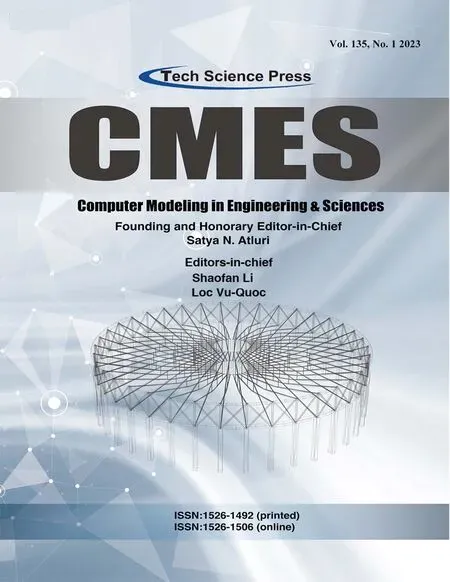 Computer Modeling In Engineering&Sciences2023年4期
Computer Modeling In Engineering&Sciences2023年4期
- Computer Modeling In Engineering&Sciences的其它文章
- A Study of BERT-Based Classification Performance of Text-Based Health Counseling Data
- Overview of Earth-Moon Transfer Trajectory Modeling and Design
- CEMA-LSTM:Enhancing Contextual Feature Correlation for Radar Extrapolation Using Fine-Grained Echo Datasets
- The Class of Atomic Exponential Basis Functions EFupn(x,ω)-Development and Application
- Corpus of Carbonate Platforms with Lexical Annotations for Named Entity Recognition
- Unique Solution of Integral Equations via Intuitionistic Extended Fuzzy b-Metric-Like Spaces
